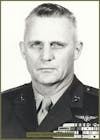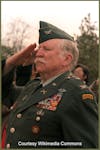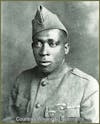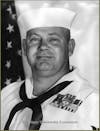US Army Tsgt William Bader: Silver Star Hero of WWII
On this episode of Duty & Valor you'll hear the story of US Army Tsgt. William Bader, a man who was awarded a Silver Star for saving the life of a fellow soldier. He was a hero to his nation and I'm honored to tell you his ...
On this episode of Duty & Valor you'll hear the story of US Army Tsgt. William Bader, a man who was awarded a Silver Star for saving the life of a fellow soldier. He was a hero to his nation and I'm honored to tell you his story.
Please visit our website to learn more about other American Heroes.
www.dutyandvalor.com
Sources:
wickedlocal.com
Legacy.com
deathonnews.com
hammondstar.com
vetcoices.wordpress.com
loc.gov
Thank you for listening to Duty & Valor!
Music by Amelie Leclerc. Artist's other music can be found here.
Please follow us on your favorite social media site.
Facebook
Instagram
Twitter
YouTube
Intro
Welcome back everyone. Today's episode of Duty & Valor came to us as a listener's recommendation. She, and others, are proud of having a veteran of his caliber in their family and they wanted his story shared. Today you’ll hear the story of a man who, though fresh out of high school, wanted to fight for his nation during WWII. A man who volunteered to carry a machine gun that he knew would make him a target of enemy fire. A man who regularly put himself in harm's way to make sure his unit achieved its objective. A man who risked his life to save his squad leader from certain death. This is the story of Silver Star recipient US Army Technical Sergeant William Bader.
William was born in Norton, MA on April 3rd, 1923 to parents Rose and David Bader. He was one of seven siblings and the youngest of five boys. He graduated high school in 1941 and later that year the US entered WWII. Wanting to serve his nation, William started the process to enter military service in the US Army Air Corps. He took and passed the Air Corps Cadet Exam setting him to do so. However, as she already had 3 of five sons in the military, his mother wouldn’t sign off on allowing him to join. Not only did she refuse to allow him to join, she actively tried to keep him from getting drafted by contacting military officials to explain the sacrifice that their family was already making.
A sacrifice that was paid in blood on May 29th, 1943 when William’s brother Nahannie was killed in action. Nahannie, a Staff Sergeant, was a waist gunner aboard a B-17, The Concho Clipper, when it was hit by German flak and crashed in North Western France.
For some time his mother’s effort was succeeding in keeping William out of the war. But eventually he did receive a draft notification. In February 1944, William was notified that he would be joining the Army. He was sent to Camp Blanding in Florida for basic military training before being sent back north, where he was transported from NY to England for further training. From there he was sent across the English channel to Omaha beach on the Normandy coast. This was after the allied invasion a few months earlier and the Army was using this area for additional training.
William was then put on a train with other fresh troops and was sent towards Paris where he found out that he would be assigned to the 5th Infantry Division, 2nd Infantry Regiment, 1st Battalion. William was now serving under General Patton, which was something that he was proud of.
William and the other replacements were then put into four trucks and sent to connect with the rest of their unit. When they arrived, William naively asked one of the men why they needed four trucks of replacements. The man replied that they had recently lost a lot of men.
The 5th had just concluded the hard fought Battle of Metz where they had to dislodge the heavily dug in Germans at the village of Metz in North Eastern France. The US was eventually victorious, but the months-long battle took a heavy toll on the US forces.
Once the men got off the trucks, an NCO asked who had any experience with a BAR, which was the Browning Automatic Rifle. William raised his hand, as he had fired it during training, and he was quickly assigned his very own BAR. In what must have been a sight to behold, the 5’7”, 125 pound William was given the almost six foot long gun. William knew that the automatic rifle always drew the attention of enemy fire, but he knew the importance of his role and would man that gun during three ground offensives.
The first combat action that William saw was against the Germans in a heavily forested area of Belgium. William recalled being fed a good Christmas meal the day before he and the other men of his unit walked into battle. It wasn’t until after the battle that he realized its significance. William fought at the Battle of the Bulge, where the allied forces had halted the last major German offensive of the war.
After the battle, the front lines were moving further East and the Allies were fighting the Germans on their own soil. Their unit was pinned down by two machine gun emplacements. They fought back with all they had but they couldn’t dislodge the Germans. After some time, William and three other men volunteered to engage them from another direction. They back tracked and came up behind the unsuspecting Germans. They were able to engage them at a close range with grenades and rifle fire and they neutralized both guns. The actions of William and the other men minimized American casualties and allowed their unit to advance. William was awarded a Bronze Star for this action.
Not long after, William and about twenty men were making their way into the German town of Schwarzenborn. The men had intel that the Germans had left the town and they weren’t expecting any resistance. However, this wasn’t the case at all. What they faced instead was a trap set up by the Germans. As the men approached the small farming town from the East, with the sun shining in their faces, the Germans opened fire on them from concealed positions behind them. The men, who were out in the open, raced toward a barn that was approximately 50 yards away.
After they made it inside, Sgt. Campo, a squad leader, yelled at William to bring his BAR, the radio man, and a medic forward. The men were surrounded and fired upon by the Germans on three sides. In addition to the small arms, grenades, and mortars being fired at them, the Germans were also supported by Tiger tanks.
The only chance the men had was to call in artillery support. Unfortunately, they had no map in hand and couldn’t provide precise coordinates. With smoke rising from the barn, the radio man was told to call in artillery fire, around the smoke. Asked to confirm this direction, as it could mean friendly casualties. He confirmed the order as they had to take that chance, otherwise the Germans would soon bring the barn down on them.
What was most feared happened. An artillery shell fell directly on the barn’s roof. Shrapnel killed Sgt. Campo , the medic, and the radioman. William survived the blast but he sustained a wound to his shoulder.
Not far away, but hidden by the darkness of the barn, William heard another man, Sgt. Galgano called out for help. Sgt. Galgano was badly injured in his arm and left leg. William described his leg wound as looking like a football that was split open from end to end. William treated his wounds the best he could and then said, “Tony, I’m going to get you out of here.”
As Sgt. Galgano weighed approximately 185 pounds without any gear, this wasn’t going to be easy for William to do. He found a door nearby and slowly opened it to look out. He saw a Tiger firing at any perceived movements or where they saw the muzzle flashes of American guns.
Across the road, William saw a tree line and he knew he had to get across it. He crawled across that road while aiding Sgt. Galgano along. The men quietly made it to the tree line and continued away from the barn before William saw a Jeep. He made his way to them and told them to evacuate Sgt. Galgano. The men quickly loaded him aboard and told William to jump on as well. William said no, and that he was going back to the other men. William said that he didn’t know how he and Sgt. Galgano made it across the road safely, but he now had to do the same in reverse.
William slowly made his way across the road and back into the barn. He joined he beleaguered men and they fought hard and held off the Germans throughout the night. As the sun was beginning to rise, there were only seven men left. They knew they would soon be overrun, so they devised a plan to leave the barn. The men raced out of the barn and down the road at full sprint. They ran up a nearby knoll where they were fired upon by a machine gun emplacement. They weren’t in position to neutralize it so they continued forward.
When they were out of immediate danger, the men stopped to catch their breath. One man asked if William was okay, and he said “yes, just have some metal in my shoulder from the artillery round.” The man said “no, your head.”
William removed his helmet and saw a quarter sized hole in the back of his helmet and an exit hole in the front. Miraculously an enemy round had narrowly missed hitting William in his head.
Soon after, the men captured an old German man and forced him to point out the German gun emplacements in the area. Their positions were relayed to their command post and they were soon taken out of commission. The old man was turned over to military police where he was assumed to be placed under arrest, though William couldn’t confirm this.
For his actions that day, William was awarded a purple heart for wounds and a Silver Star for his heroic rescue of Sgt. Galgano.
Following the war, William returned to Massachusetts, but since there was a two to three year long wait list to enter college, he and a few friends headed south to play baseball. He ended up attending Southeastern Louisiana College in Hammond, Louisiana. He did play baseball there and joined the Hammond Berries, the town's minor league team. He married Doris and the two had three children Rebecca, Nora, and William. He then dedicated his life to teaching. He was a math teacher and served as principal for many years until he retired.
Tech. Sgt. William Bader passed away on March 8, 2023, at his home in Hammond.
Tech. Sgt. William Bader was a man who had a tremendous impact during his short time in combat. His actions saved the lives of many of the men around him and they, along with his nation, are forever grateful for his valor and selfless courage.
In addition to Staff Sergeant Nahannie Bader, the other men that were killed in action when The Concho Clipper went down in France were Technical Sergeant Wayne Baldwin, a radio operator and ball turret gunner; Staff Sergeant Maurice McLaughlin, ball turret gunner; and Technical Sergeant James Welk, top turret gunner.
The following crew were captured and taken prisoner by the Germans. Staff Sergeant Charles Eaton, a waist gunner; Flight Officer Leo Grikstas, co-pilot;; Lt. Colonel J. Russell, pilot; 2nd Lt. Roy Stealey, navigator; Staff Sergeant Frederick Williams, tail gunner; and 1st Lt. Charles Woehrle, bombardier.
Thank you for listening to this episode of Duty & Valor. To read more about this week’s hero, check out the sources used in today's episode in our show notes and at dutyandvalor.com.
If you haven’t done so already, please take a moment to follow and review us wherever you’re listening. And please join us for our next episode, where we'll be sharing the inspiring story of another American hero who served with pride and lived with humility.




















